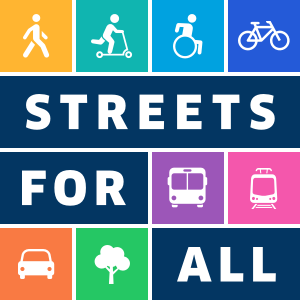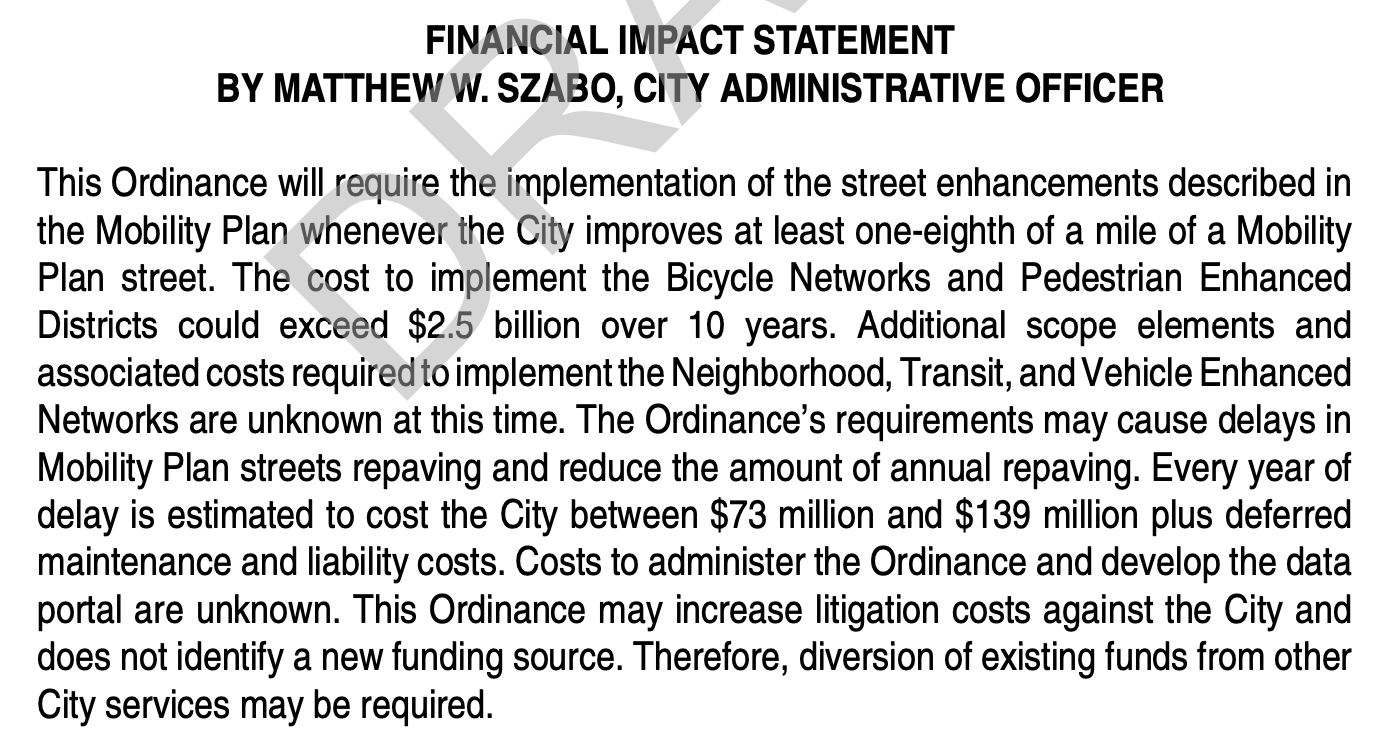UPDATE: On Friday, February 16, 2024, the CAO released a last minute, even more misleading report, claiming the cost has now gone up to $3.1B! The main reason he claims for the increase is the repair of 9’ sidewalks compared to 6’ sidewalks; nothing in the Mobility Plan requires sidewalk repair, and therefore HLA does not require sidewalk repair. The arguments below stand, and we call on the CAO to stop playing politics with the lives of Angelenos. Read our call to action from that day.
The City Administrative Officer wrote this summary for his stated financial impact of Measure HLA:
The CAO’s cost estimate is exaggerated and misleading:
The CAO estimate does not provide any source for their cost estimates, but we can examine the similar Mobility Plan 20235 implementation cost report submitted to the LA City Council in November 2023 to understand their analysis:
More than half the CAO’s cost estimate is for sidewalk repair, which is not required by the Mobility Plan, and therefore not required by HLA.
Notwithstanding this expense not being required by HLA, the City already has a $1.4B budget to repair sidewalks over 30 years thanks to the Willits Settlement; saddling the cost of repairing sidewalks on the ballot measure is misleading, and untrue, and this represents more than half the cost the CAO estimates.
For the Pedestrian Enhanced Network, the CAO assumes exaggerated maximal costs. The City has never completed a comprehensive citywide sidewalk assessment, so it is assumed the whole network must be upgraded to meet ADA standards: “since the overall condition of the sidewalks is unknown, the total estimated cost to remediate the sidewalks is $1.4 billion assuming all 560 miles in the PED needs repair.” The City, obviously, will not need to repair every foot of sidewalk on the pedestrian network as many portions of sidewalks are already in good condition.
Measure HLA saves money in the long term. If the goal of the City is to implement its own Mobility Plan 2035, then it makes sense to do it during repaving, when the street has to be restriped and redesigned anyway. Otherwise, the City would have to go back later, tear up the street and redo it.
The CAO’s cost estimate assumes that the entire Mobility Plan 2035 has to be implemented by 2035; while we would love to see that, nothing in Measure HLA dictates that the City has to implement their own Mobility Plan by any specific date.
The CAO report assesses the cost of implementing the Bicycle Networks between $1 - $1.3 billion at around $2 million per mile. This is nearly 10x the cost of what LADOT says it spends per mile of bike lanes. View a full breakdown here.
The CAO doesn’t even attempt to give a cost to implement the Neighborhood Enhanced Network, Vehicle Enhanced Network, or the Transit Enhanced Network. These are all made up of low cost improvements.
The NEN would likely be made up of low cost speed improvements similar to the existing Slow Street program; this means paint, signage, and plastic bollards.
The VEN would largely be made up of cheap and already funded signal improvements and signage changes (changing parking to off-peak, etc.).
The TEN would improve the installation of bus lanes which are funded by Metro Los Angeles and bus shelters (an existing newly funded program).
The City currently spends tens of millions of dollars per year paying out to victims of traffic violence, in some cases, more than it budgets towards safer streets. If we implement the Mobility Plan, we would save the City money on litigation costs, in addition to saving lives.
Every year more than 300 people die on our streets and thousands are permanently injured because we haven’t invested in safe infrastructure. We are bearing the burden of decades of underinvestment and poor planning on LA streets. While we believe the CAO estimate is significantly inflated, even $2.5 billion over 10 years for safer streets, cleaner air, and less traffic would be a valuable investment. For comparison, it is less than NYC’s planned spending of $4 billion just on vision zero over the next 10 years (a city with fewer miles of streets) where investments have successfully reduced traffic fatalities. The bottom line is the City Council passed the Mobility Plan 2035 back in 2015 and the City has barely implemented any of it. It should not be sticker shock to keep Angelenos safe when crossing the street, and the cost should not be misrepresented to voters.

